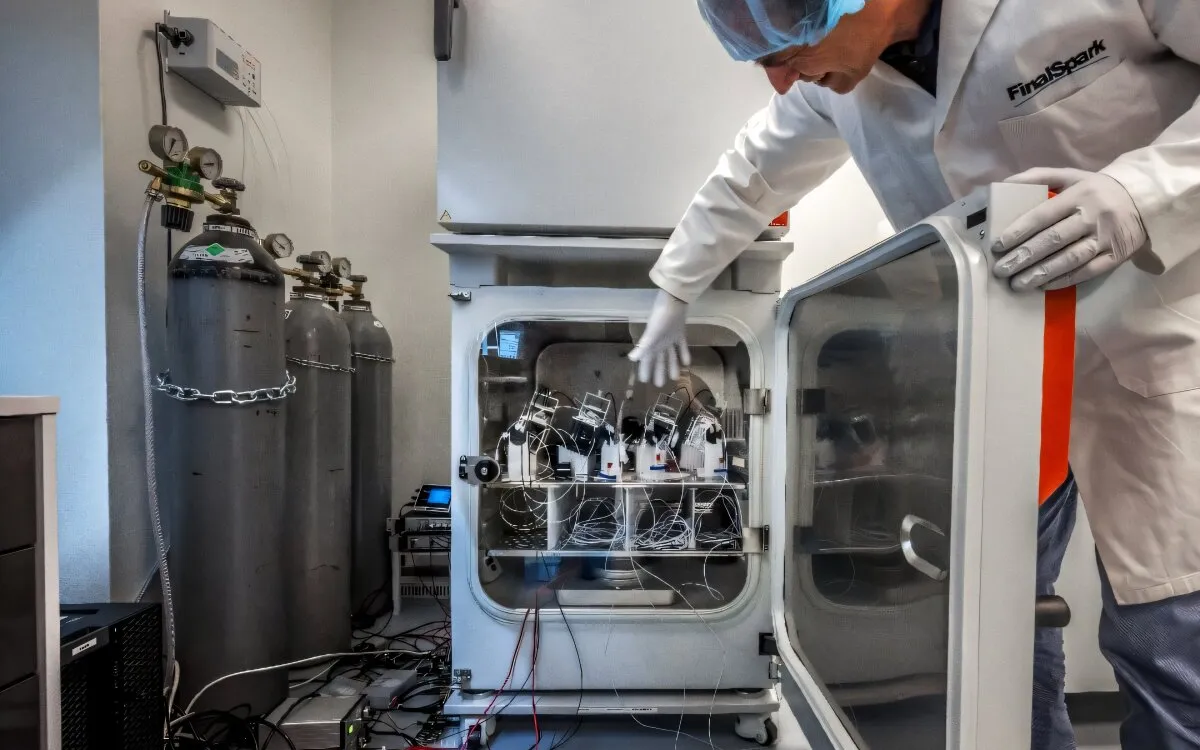
Inside a lab nestled in the scenic Swiss town of Vevey, a dedicated scientist carefully nourishes tiny clumps of human brain cells with the essential nutrient-rich fluid necessary for their survival. These miniature brains, often referred to as brain organoids, are critical in the burgeoning field of biocomputing, which seeks to leverage the sophisticated yet enigmatic computing abilities of the human brain. Unlike conventional electronics, once these biological processors perish, they cannot be rebooted, making their health paramount.
During a recent tour of the innovative Swiss start-up, FinalSpark, co-founder Fred Jordan shared his ambitious vision with AFP. He envisions a future where processors powered by real brain cells could supplant the silicon chips currently driving the artificial intelligence (AI) revolution. Presently, the supercomputers that power AI technologies like ChatGPT rely heavily on silicon semiconductors to emulate the neural networks of the human brain. Jordan suggests a more straightforward approach: "Instead of trying to mimic, let's use the real thing."
One of the most alluring advantages of biocomputing is its potential to mitigate the escalating energy demands associated with AI technologies. These demands have already posed significant challenges to climate goals, prompting some tech giants to explore alternative energy sources, including nuclear power. Jordan emphasizes that biological neurons boast a remarkable energy efficiency—reportedly one million times more efficient than their artificial counterparts. Furthermore, these neurons can be endlessly cultivated in labs, contrasting sharply with the high-demand AI chips produced by industry giants like Nvidia.
Despite its promise, the computing capabilities of wetware remain far from rivaling the existing hardware that underpins global technology. The question of whether these organoids could develop consciousness also looms large. Jordan remarks on the philosophical implications of this potential, which is why FinalSpark collaborates with ethicists in its research endeavors.
To produce its bioprocessors, FinalSpark initially acquires stem cells derived from anonymous human skin donors. These versatile cells can transform into any cell type within the human body. The scientists at FinalSpark then differentiate these cells into neurons, which are grouped into millimeter-wide clumps known as brain organoids—roughly the size of a fruit fly's brain. Electrodes are then attached to these organoids to monitor their internal communications. By applying a small electric current, researchers can observe whether the organoids respond with increased activity, analogous to the binary code of traditional computing.
Currently, ten universities globally are conducting experiments using FinalSpark's organoids. The company even features a live feed on its website, showcasing the neurons in action. For instance, Benjamin Ward-Cherrier, a researcher at the University of Bristol, successfully utilized one of these organoids as the brain for a simple robot capable of differentiating between various Braille letters. However, challenges abound, such as encoding data into a format that the organoid can interpret and deciphering the responses from the brain cells. Ward-Cherrier humorously noted that working with robots is significantly easier than collaborating with living cells, which have finite lifespans.
At Johns Hopkins University in the United States, researcher Lena Smirnova is utilizing similar organoids to investigate brain disorders like autism and Alzheimer’s disease, aiming to discover new treatment options. She acknowledges that while biocomputing seems more theoretical at the moment, its applications in biomedical research could evolve dramatically over the next two decades.
Scientists interviewed by AFP largely dismissed the notion that these small clusters of cells could develop a form of consciousness. Jordan points out that the organoids, which contain approximately 10,000 neurons compared to the 100 billion neurons in a human brain, lack pain receptors, highlighting the significant differences between human and organoid brain functions. Despite this, much about the mechanisms of consciousness remains a mystery, prompting researchers like Ward-Cherrier to hope that biocomputing might provide insights into the workings of our own minds.
In the lab, as Jordan opens a large fridge containing 16 brain organoids connected by a network of tubes, monitoring equipment reveals unexpected spikes in neural activity. Interestingly, these brain cells exhibit no known means of sensing the door's opening, a phenomenon that has puzzled scientists for years. "We still don’t understand how they detect the opening of the door," Jordan confessed, underscoring the many unanswered questions that continue to surround the field of biocomputing.
As research in this exciting domain progresses, the potential implications of biocomputing could reshape our understanding of both technology and the human brain.